The Phytogenic Feed Additives Market is estimated to be valued at USD 1111.2 million in 2025 and is projected to reach USD 1997.5 million by 2035, registering a compound annual growth rate (CAGR) of 6.0% over the forecast period.
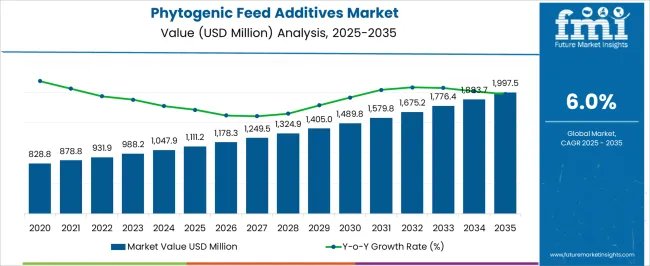
| Metric | Value |
|---|---|
| Phytogenic Feed Additives Market Estimated Value in (2025 E) | USD 1111.2 million |
| Phytogenic Feed Additives Market Forecast Value in (2035 F) | USD 1997.5 million |
| Forecast CAGR (2025 to 2035) | 6.0% |
The Phytogenic Feed Additives market is witnessing substantial growth, driven by the increasing demand for natural, plant-based feed supplements that improve livestock health and productivity. Rising awareness regarding the harmful effects of synthetic growth promoters and antibiotics is encouraging adoption of phytogenic additives in poultry, swine, and ruminant nutrition. The market is further supported by research advancements in bioactive compounds, essential oils, and herbal extracts that enhance gut health, immunity, and feed conversion efficiency.
Growing focus on sustainable livestock production and clean-label feed solutions is also propelling demand. The expansion of intensive farming practices, particularly in poultry and swine sectors, is increasing the requirement for performance-enhancing natural additives.
Additionally, the integration of advanced feed formulations and analytics-driven feeding strategies is enhancing adoption across commercial and small-scale operations As regulatory agencies globally favor natural growth promoters over antibiotics, the Phytogenic Feed Additives market is expected to maintain steady growth, with opportunities emerging from rising demand for high-quality, safe, and sustainable livestock nutrition solutions.
The phytogenic feed additives market is segmented by end-use type, packaging type, distribution channels, and geographic regions. By end-use type, phytogenic feed additives market is divided into Poultry Owners, Poultry Shops, and Others. In terms of packaging type, phytogenic feed additives market is classified into Flexible Packaging, Pouches, Bags, Rigid Packaging, Cans, Boxes/Cartons, Chubbs, Jugs/Tubs, Trays, and Other. Based on distribution channels, phytogenic feed additives market is segmented into Internet Retailing, Mass Retailers, Pet Shops, Super/Hypermarkets, Discounters, Veterinary Clinics, Direct Selling, and Others. Regionally, the phytogenic feed additives industry is classified into North America, Latin America, Western Europe, Eastern Europe, Balkan & Baltic Countries, Russia & Belarus, Central Asia, East Asia, South Asia & Pacific, and the Middle East & Africa.
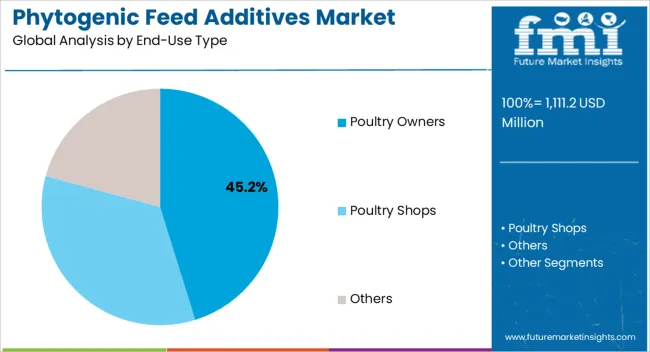
The poultry owners segment is projected to hold 45.2% of the market revenue in 2025, establishing it as the leading end-use category. Growth in this segment is being driven by the widespread adoption of intensive poultry farming practices and the increasing demand for high-quality meat and eggs. Phytogenic feed additives are being leveraged to improve gut health, enhance nutrient absorption, and boost overall productivity without reliance on synthetic growth promoters or antibiotics.
The ability to reduce disease incidence and improve feed conversion ratios provides both economic and operational advantages for poultry owners. Rising consumer awareness regarding food safety and natural production practices further supports adoption.
Moreover, technological advancements in feed formulations and the availability of customized phytogenic blends are enhancing their efficacy and application in poultry farming As the global poultry industry continues to expand and regulations favor natural feed additives, the poultry owners segment is expected to maintain its leadership, driven by the benefits of sustainable, efficient, and health-promoting nutrition solutions.
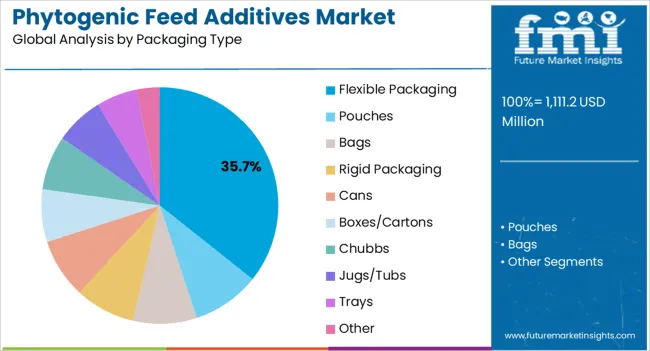
The flexible packaging segment is anticipated to account for 35.7% of the market revenue in 2025, making it the leading packaging type. Growth in this segment is being driven by the increasing need for convenient, cost-effective, and protective packaging solutions that maintain the quality and stability of phytogenic feed additives. Flexible packaging formats, including pouches and bags, enable efficient storage, handling, and distribution, particularly in small-scale and commercial farming operations.
This packaging type also facilitates better shelf-life management and protection from moisture, light, and contamination, ensuring product efficacy until consumption. The ease of transportation and reduced material costs further enhance its appeal to both manufacturers and end users.
Increasing preference for ready-to-use, portable, and convenient feed additive solutions among poultry and livestock owners is reinforcing adoption As companies focus on sustainable and efficient packaging solutions while maintaining product integrity, the flexible packaging segment is expected to sustain its leading position, driven by operational efficiency, cost-effectiveness, and improved product usability across the feed industry.
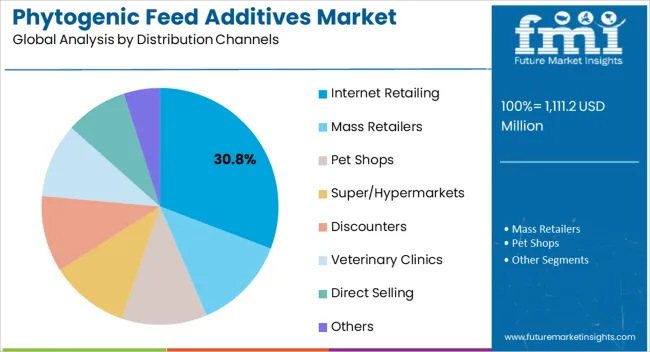
The internet retailing distribution channel is projected to hold 30.8% of the market revenue in 2025, establishing it as the leading distribution method. Growth in this segment is being driven by the increasing penetration of e-commerce platforms, which provide convenient and direct access to feed additives for poultry and livestock owners. Online channels enable farmers to compare product offerings, place bulk orders, and access customized recommendations, enhancing purchasing efficiency.
The expansion of digital infrastructure and mobile connectivity in rural and semi-urban areas has further facilitated adoption of internet retailing. Additionally, online platforms allow manufacturers and distributors to reach geographically dispersed customers, reducing dependency on traditional retail networks.
Increasing emphasis on timely delivery, competitive pricing, and product availability has strengthened the preference for online purchasing As farmers seek convenience, product transparency, and accessibility, the internet retailing segment is expected to maintain its market leadership, driven by e-commerce growth, enhanced customer engagement, and the operational benefits of direct-to-consumer distribution models in the feed additive industry.
Phytogenic feed additives are plant-derived products used in feed to potentially improve poultry performance. Aside from possessing antimicrobial activity, phytogenic feed additives provides potentially anti-oxidative effects, enhance palatability, improve gut functions, and promote growth in poultry.
Phytogenic feed additives comprises of herbs and plants derivatives. The rising health concerns make phytogenic feed additives a practical choice for each and every individual involve in poultry business. In many ways, phytogenic feed additives can be much more beneficial compared to antibiotics which are infused in poultry for improving health and productivity of poultry.
With rise in demand of poultry products from consumers and more emphasize on improving poultry health will catapult the market of phytogenic feed additives.
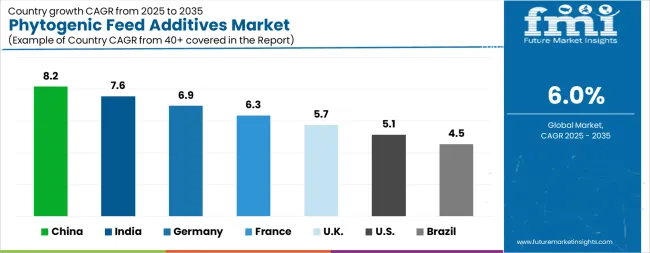
| Country | CAGR |
|---|---|
| China | 8.2% |
| India | 7.6% |
| Germany | 6.9% |
| France | 6.3% |
| UK | 5.7% |
| USA | 5.1% |
| Brazil | 4.5% |
The Phytogenic Feed Additives Market is expected to register a CAGR of 6.0% during the forecast period, exhibiting varied country level momentum. China leads with the highest CAGR of 8.2%, followed by India at 7.6%. Developed markets such as Germany, France, and the UK continue to expand steadily, while the USA is likely to grow at consistent rates. Brazil posts the lowest CAGR at 4.5%, yet still underscores a broadly positive trajectory for the global Phytogenic Feed Additives Market. In 2024, Germany held a dominant revenue in the Western Europe market and is expected to grow with a CAGR of 6.9%. The USAPhytogenic Feed Additives Market is estimated to be valued at USD 408.4 million in 2025 and is anticipated to reach a valuation of USD 673.7 million by 2035. Sales are projected to rise at a CAGR of 5.1% over the forecast period between 2025 and 2035. While Japan and South Korea markets are estimated to be valued at USD 52.5 million and USD 29.6 million respectively in 2025.
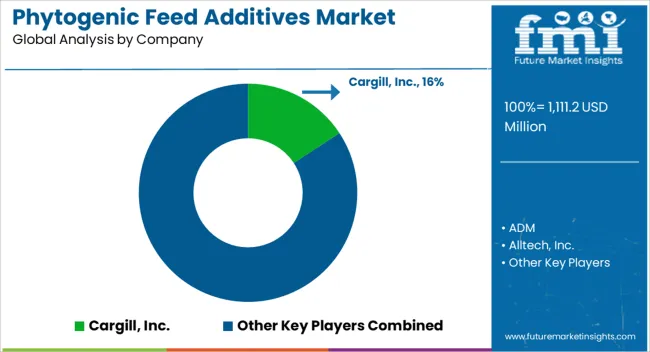
| Item | Value |
|---|---|
| Quantitative Units | USD 1111.2 Million |
| End-Use Type | Poultry Owners, Poultry Shops, and Others |
| Packaging Type | Flexible Packaging, Pouches, Bags, Rigid Packaging, Cans, Boxes/Cartons, Chubbs, Jugs/Tubs, Trays, and Other |
| Distribution Channels | Internet Retailing, Mass Retailers, Pet Shops, Super/Hypermarkets, Discounters, Veterinary Clinics, Direct Selling, and Others |
| Regions Covered | North America, Europe, Asia-Pacific, Latin America, Middle East & Africa |
| Country Covered | United States, Canada, Germany, France, United Kingdom, China, Japan, India, Brazil, South Africa |
| Key Companies Profiled | Cargill, Inc., ADM, Alltech, Inc., Kemin Industries, Inc., DSM-Firmenich, Evonik Industries AG, Nutreco (Selko), Adisseo, DuPont (IFF), Natural Remedies, and Nuevo |
The global phytogenic feed additives market is estimated to be valued at USD 1,111.2 million in 2025.
The market size for the phytogenic feed additives market is projected to reach USD 1,997.5 million by 2035.
The phytogenic feed additives market is expected to grow at a 6.0% CAGR between 2025 and 2035.
The key product types in phytogenic feed additives market are poultry owners, poultry shops and others.
In terms of packaging type, flexible packaging segment to command 35.7% share in the phytogenic feed additives market in 2025.






Our Research Products

The "Full Research Suite" delivers actionable market intel, deep dives on markets or technologies, so clients act faster, cut risk, and unlock growth.

The Leaderboard benchmarks and ranks top vendors, classifying them as Established Leaders, Leading Challengers, or Disruptors & Challengers.

Locates where complements amplify value and substitutes erode it, forecasting net impact by horizon

We deliver granular, decision-grade intel: market sizing, 5-year forecasts, pricing, adoption, usage, revenue, and operational KPIs—plus competitor tracking, regulation, and value chains—across 60 countries broadly.

Spot the shifts before they hit your P&L. We track inflection points, adoption curves, pricing moves, and ecosystem plays to show where demand is heading, why it is changing, and what to do next across high-growth markets and disruptive tech

Real-time reads of user behavior. We track shifting priorities, perceptions of today’s and next-gen services, and provider experience, then pace how fast tech moves from trial to adoption, blending buyer, consumer, and channel inputs with social signals (#WhySwitch, #UX).

Partner with our analyst team to build a custom report designed around your business priorities. From analysing market trends to assessing competitors or crafting bespoke datasets, we tailor insights to your needs.
Supplier Intelligence
Discovery & Profiling
Capacity & Footprint
Performance & Risk
Compliance & Governance
Commercial Readiness
Who Supplies Whom
Scorecards & Shortlists
Playbooks & Docs
Category Intelligence
Definition & Scope
Demand & Use Cases
Cost Drivers
Market Structure
Supply Chain Map
Trade & Policy
Operating Norms
Deliverables
Buyer Intelligence
Account Basics
Spend & Scope
Procurement Model
Vendor Requirements
Terms & Policies
Entry Strategy
Pain Points & Triggers
Outputs
Pricing Analysis
Benchmarks
Trends
Should-Cost
Indexation
Landed Cost
Commercial Terms
Deliverables
Brand Analysis
Positioning & Value Prop
Share & Presence
Customer Evidence
Go-to-Market
Digital & Reputation
Compliance & Trust
KPIs & Gaps
Outputs
Full Research Suite comprises of:
Market outlook & trends analysis
Interviews & case studies
Strategic recommendations
Vendor profiles & capabilities analysis
5-year forecasts
8 regions and 60+ country-level data splits
Market segment data splits
12 months of continuous data updates
DELIVERED AS:
PDF EXCEL ONLINE
Feed Phytogenics Market Size and Share Forecast Outlook 2025 to 2035
Feed Phytogenic Market Analysis - Size, Share, & Forecast Outlook 2025 to 2035
Aqua Feed Additives Market Analysis by Species Type, Ingredient and Other Additives Types Through 2035
A detailed global analysis of Brand Share Analysis for Aqua Feed Additives Industry
Novel Feed Additives Market – Trends, Demand & Livestock Innovations
Animal Feed Additives Market Analysis - Size, Share, & Forecast Outlook 2025 to 2035
Analyzing Animal Feed Additives Market Share & Industry Leaders
Natural Feed Additives Market Analysis - Size, Growth, and Forecast 2025 to 2035
USA Aqua Feed Additives Market Trends – Growth, Demand & Forecast 2025–2035
Medicated Feed Additives Market Size and Share Forecast Outlook 2025 to 2035
UK Animal Feed Additives Market Trends – Growth, Demand & Forecast 2025–2035
Microbial Feed Additives Market – Growth, Probiotics & Livestock Nutrition
Postbiotic Feed Additives Market Analysis - Size and Share Forecast Outlook 2025 to 2035
United States Animal Feed Additives Market Report – Trends, Growth & Forecast 2025–2035
Europe Aqua Feed Additives Market Report – Demand, Trends & Forecast 2025–2035
ASEAN Animal Feed Additives Market Insights – Demand, Size & Industry Trends 2025–2035
Antimicrobial Feed Additives Market Analysis - Size and Share Forecast Outlook 2025 to 2035
Europe Animal Feed Additives Market Insights – Size, Trends & Forecast 2025–2035
Australia Aqua Feed Additives Market Insights – Size, Share & Trends 2025-2035
Australia Animal Feed Additives Market Analysis – Size & Industry Trends 2025–2035

Thank you!
You will receive an email from our Business Development Manager. Please be sure to check your SPAM/JUNK folder too.
Chat With
MaRIA